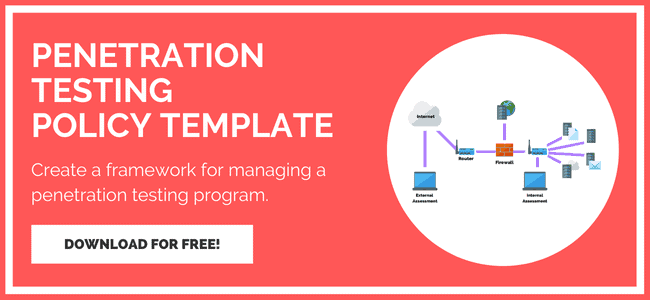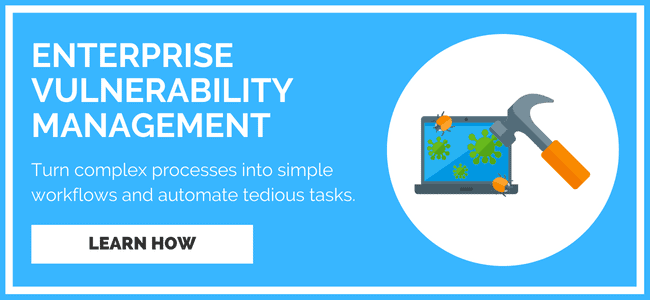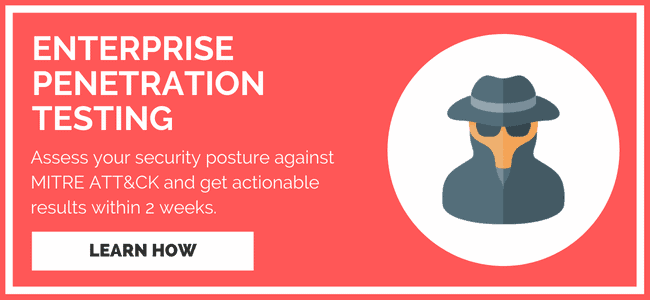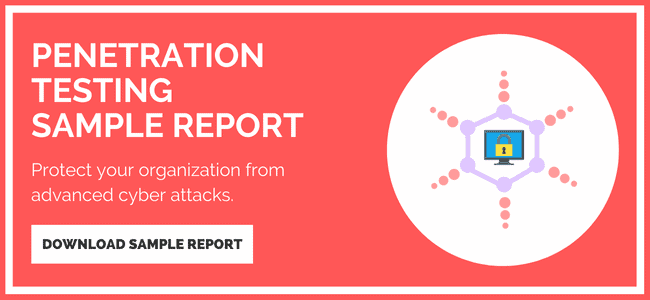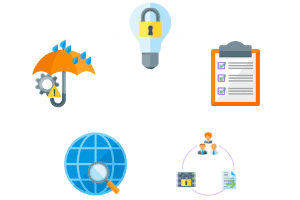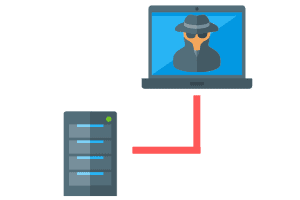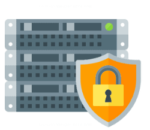Previous
What Is Cloud Penetration Testing? (& When Do You Need It?)
Assess and validate your security with PurpleSec’s penetration testing services.
Author: Eva Georgieva / Last Updated: 11/26/2022
Reviewed By: Michael Swanagan, CISSP, CISA, CISM & Seth Kimmel, OSCP
View Our: Editorial Process
Table Of Contents
What You’ll Learn
- What a cloud penetration test is and why it’s important.
- When you might need a pen test for your cloud environment.
- The top cloud vulnerabilities that you can’t ignore.
- Methodologies used when performing a cloud pen test.
What Is Cloud Penetration Testing?
Cloud Penetration Testing is the process of detecting and exploiting security vulnerabilities by simulating a controlled cyber attack on cloud-native systems, where the cloud infrastructure’s security posture is assessed.
Typically this type of penetration test is performed is under strict guidelines from the cloud services like Google Cloud Provider or AWS.
The overall goal is to expose security vulnerabilities, risks and possible security gaps between the actual level of digital security and the assumed or required level of security needed.
Cloud VS Traditional Penetration Testing
Cloud penetration testing is a more recent concept specifically in pen testing. While security testing of a cloud environment is quite different from a traditional penetration test, the fundamentals are still the same.
However, traditional penetration testing methodologies are not cloud-native and they focus on processes that are more relevant to on-premise environments.
When it comes to traditional pen testing, the organization that requests the pentest is the asset owner of the entire technical infrastructure. In contrast, in an assessment of a cloud environment, the cloud service provider owns the assets that are available for the clients to use.
The methodology and the tooling used to conduct the penetration set in a cloud environment also differ from a traditional pentest setting.
Cloud penetration testing requires unique and specific expertise that is different from standard penetration testing.
A cloud specific pentest examines the security of cloud systems, application, databases, storage access, cloud specific configurations where different rules and policies apply that are also set in a different way than in a traditional on-premise environment.
In addition, cloud penetration testing is also influenced by the Shared Responsibility Model that cloud service providers enforce which states that since you are using its service, the services that you are configuring are your own responsibility.
Types Of Cloud Penetration Testing
The different types of cloud penetration testing use more or less the same “boxing” type used as when it comes to standard penetration testing.
- Black Box – A black box penetration test presents an attack simulation in which the cloud penetration testers have no prior knowledge regarding the posture of the infrastructure and can only look at it as would a normal user. That is the perspective from which the simulated attack is carried out. The penetration testers also do not have access to your cloud systems.
- Gray Box – In a gray box cloud penetration testing approach, the penetration testers have some limited knowledge of your cloud infrastructure and have limited access to your cloud systems, even some limited administrative privileges.
- White Box – In a white box cloud penetration testing process, the penetration testers are aware of almost everything regarding your cloud systems and they are usually granted different roles within the system including admin or root level access.
When Do I Need A Cloud Penetration Test?
If your infrastructure is in the cloud and you are using a Cloud Service Provider’s services it is highly recommended to pentest your environment and make a cloud pentest a part of your cyber security strategy.
As mentioned in the shared responsibility model, the cloud providers are responsible for the infrastructure that runs the services, however, it is your responsibility to protect and secure the services that you are using.
A cloud pen test is more than just automated scanning for security vulnerabilities.
It brings different expertise and approaches to analyze the vulnerabilities, assess your environment from an adversary point of view, and identify vulnerabilities and security issues that could prevent your cloud environment from operating at optimal performance.
Even if you have a mature cyber security program a cloud penetration test will let you know how effective your security controls are at preventing cyber attacks.
Why Cloud Penetration Testing Is Important
Companies are rapidly shifting from on-premise hosted infrastructure to cloud hosted infrastructure as a service (IaaS).
Even though the core of the cloud hosted infrastructures are built based on the traditional networking model, the shift, especially in a security sense is not as straightforward.
Just migrating an infrastructure to the cloud does not guarantee security, redundancy, or reliability.
The most common cloud security issues that get overlooked include:
- Default service accounts with excessive privileges.
- Misconfigurations that expose sensitive data, like public S3 buckets.
- Lack of personnel that has the necessary expertise to manage the cloud applications and properly secure the services.
- Lack of knowledge of how the relationships work and how the access controls between those provisioned cloud resources function.
- Lack of visibility.
- Lack to establish a security policy that would prevent or detect misconfigurations or weakly or improperly configured security settings.
- Publicly exposed Cloud services.
Ignoring the security of your cloud services that leads to a compromised account or exploited vulnerability could then be the reason the account is closed by the service provider.
Cloud Vulnerabilities That Shouldn’t Be Overlooked
Some of the biggest cloud security vulnerabilities that may arise and should be paid specific attention to when it comes to cloud security are the following:
Insecure APIs
APIs are a way for two or more computer programs to communicate with each other.
They are largely used in services that cloud providers offer to share information across various applications.
Insecure APIs can lead to the exposure of sensitive information and large-scale data leaks.
Related article: 9 Data Security Strategies You Need To Implement
The main business risk of an insecure API depends on its usage and the type of data that is associated with it, as well as how quickly the vulnerability is detected and remediated.
Usually, the most common vulnerability found is the unintended exposure of sensitive information left unsecured by the API.
Improper access control or lack of input sanitization is also one of the most common issues detected in APIs from a security standpoint.
This could all be detected by a cloud penetration test.
Service Misconfigurations
Next to insecure APIs, cloud service misconfigurations are one of the most frequently occurring cloud vulnerabilities.
Cloud misconfiguration refers to any glitches, gaps, or errors that could expose your environment to risk during cloud adoption.
The most common misconfigured service is AWS S3 buckets, which typically leads to the largest data breaches since that’s where sensitive data is typically stored.
Other cloud security misconfigurations include:
- Unrestricted inbound ports.
- Unrestricted outbound ports.
- Disabled monitoring and logging.
- Open ICMP ports.
- Insecure automated backups.
- Overly permissive access to virtual machines.
- Containers and hosts.
- Development settings in production environments.
- Default credentials for systems.
Weak Credentials
Using passwords that are weak, too common, or reusing passwords can make cloud accounts vulnerable to different types of password-guessing attacks.
Threat attackers can use automated tools to try and guess the credentials which could present an entry vector into the account.
Outdated Software
When we talk about outdated software vulnerabilities, we are typically talking about third-party software.
If a vulnerability is found or disclosed the software publisher fixes the issue and publishes an updated version of the software that is not vulnerable.
In that case, it is crucial to install the updated version as quickly as possible.
Unpatched vulnerabilities could easily be exploited and present an access point to the cloud services you’re using.
Automated scanners are able to detect unpatched vulnerabilities, which threat actors tend to search for as it’s the easiest point of entry.
That is why it is crucial that patching is done properly and quickly.
Insecure Identity And Access Management
Identity and Access Management, also known as IAM, is a core component of virtually any modern application environment.
It provides a systematic way to assign roles and permissions to users and groups and plays a crucial role in securing resources, mitigating security vulnerabilities, and enforcing the principle of least privilege.
The insecure setup of IAM is a common vulnerability in cloud systems.
This usually occurs when a user or service of your infrastructure has access to resources they should be able to access or do not need in order to do their job.
Insecure Coding Practices
Application layer security is more important than ever, especially when it comes to cloud workloads.
Attention to secure coding practices can prevent vulnerabilities from being introduced when you implement and use an application.
Vulnerabilities that occur when it comes to insecure coding practices are:
- Hard-coded credentials.
- Improper exception handling.
- Lack of rate limiting.
- Single layered defense.
Cloud Pen Testing Methodology
The Cloud Pentesting Methodology mainly differs in one step from the traditional pen testing methodology and approach.
That is usually the first step of the cloud pentesting methodology which mainly deals with understanding the policies of the cloud provider which is not something that is needed when penetration testers deal with on-premise environments.
The cloud methodology consists of the following steps:
Evaluation
In this step, the penetration testers are trying to understand the Cloud Provider policies and existing Cloud SLAs.
Scoping
In this phase, the penetration testers create the testing plan, agree on IPs in scope, and sometimes identify the tools being used.
The goal is to prevent or limit any disruption to business operations. This is done in order to avoid any miscommunication between the pen tester and the client.
Reconnaissance
This is usually the beginning of the technical part of the pen test. The penetration testers gather as much information as possible about the target environment in order to help them with the exploitation phase.
This kind of information includes existing roles, accounts, ssh keys and more.
Exploitation
In this phase, the penetration testers focus to assess your cloud environments:
- Resiliency to attack.
- The coverage of your security monitoring
- Detection capabilities’ efficacy.
Reporting
The most important phase from a client’s perspective is the reporting phase.
Pen testers gather all the information and vulnerabilities found from the engagement, how to reproduce and how to remediate them, and then write it down in a professional report.
Challenges In Cloud Pen Testing
As cloud technology is more and more adopted, the challenges when it comes to ensuring security on the cloud are also changing.
The biggest challenge of course that most businesses deal with is understanding the ownership of resources.
Becoming a cloud service consumer or just mitigating your business to the cloud doesn’t mean that all the security issues now become the vendor’s problem.
Depending on the cloud model that you choose, the security responsibilities are usually separated between the vendor and the consumer.
For example, when it comes to Infrastructure as a Service (IaaS) the consumer has more control because it owns the IT infrastructure resources that are being tested.
So if a system is affected in any sort of way, the impact is usually limited to systems that the consumer owns.
On the other hand, when it comes to Software as a Service (SaaS), things change.
Since the client operates under shared infrastructure, providers may impose strict limitations on the testing activity that penetration testers can perform.
Amazon Web Services (AWS)
When it comes to AWS Cloud the Shared Responsibility Model they impose that they are responsible for protecting the infrastructure that runs all of the services that are offered in the AWS Cloud.
Customer responsibility, on the other hand, is decided by the AWS Cloud services that a customer chooses to make a part of their environment.
Google Cloud Provider (GCP)
For GCP, a similar model applies as on AWS.
They are responsible for the infrastructure security, the cloud, and the customer is responsible for anything on the cloud, anything that they can configure.
Azure Cloud Services
Azure’s Shared Responsibility Model states that the client owns its data and identities and the client should make sure that its data and identities are secure.

Eva Georgieva
Eva is a security engineer, researcher, and penetration tester with over 5 years of experience working on both red teams and blue teams.
Recent Articles
- Why Automation Is The Future Of Penetration Testing
- Continuous Penetration Testing: How To Lower Costs & Improve Security
- What Is Cloud Penetration Testing? (& When Do You Need It?)
- How To Create & Implement A Penetration Testing Policy
- White Box Penetration Testing: When Do You Need One?
- View All Resources
Categories
Policy Templates
Most Popular

